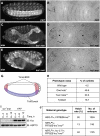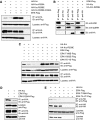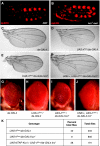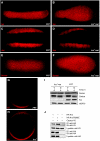β-arrestin Kurtz inhibits MAPK and Toll signalling in Drosophila development
- PMID: 20802461
- PMCID: PMC2957207
- DOI: 10.1038/emboj.2010.202
β-arrestin Kurtz inhibits MAPK and Toll signalling in Drosophila development
Abstract
β-Arrestins have been implicated in the regulation of multiple signalling pathways. However, their role in organism development is not well understood. In this study, we report a new in vivo function of the Drosophila β-arrestin Kurtz (Krz) in the regulation of two distinct developmental signalling modules: MAPK ERK and NF-κB, which transmit signals from the activated receptor tyrosine kinases (RTKs) and the Toll receptor, respectively. Analysis of the expression of effectors and target genes of Toll and the RTK Torso in krz maternal mutants reveals that Krz limits the activity of both pathways in the early embryo. Protein interaction studies suggest a previously uncharacterized mechanism for ERK inhibition: Krz can directly bind and sequester an inactive form of ERK, thus preventing its activation by the upstream kinase, MEK. A simultaneous dysregulation of different signalling systems in krz mutants results in an abnormal patterning of the embryo and severe developmental defects. Our findings uncover a new in vivo function of β-arrestins and present a new mechanism of ERK inhibition by the Drosophila β-arrestin Krz.
Conflict of interest statement
The authors declare that they have no conflict of interest.
Figures








Similar articles
-
Structure-function analysis of β-arrestin Kurtz reveals a critical role of receptor interactions in downregulation of GPCR signaling in vivo.Dev Biol. 2019 Nov 15;455(2):409-419. doi: 10.1016/j.ydbio.2019.07.013. Epub 2019 Jul 17. Dev Biol. 2019. PMID: 31325455 Free PMC article.
-
Regulation of Toll signaling and inflammation by β-arrestin and the SUMO protease Ulp1.Genetics. 2013 Dec;195(4):1307-17. doi: 10.1534/genetics.113.157859. Epub 2013 Sep 27. Genetics. 2013. PMID: 24077307 Free PMC article.
-
A MAPK docking site is critical for downregulation of Capicua by Torso and EGFR RTK signaling.EMBO J. 2007 Feb 7;26(3):668-77. doi: 10.1038/sj.emboj.7601532. Epub 2007 Jan 25. EMBO J. 2007. PMID: 17255944 Free PMC article.
-
Localized activation of RTK/MAPK pathways during Drosophila development.Bioessays. 1998 Mar;20(3):189-94. doi: 10.1002/(SICI)1521-1878(199803)20:3<189::AID-BIES1>3.0.CO;2-N. Bioessays. 1998. PMID: 9631645 Review.
-
Pattern formation by receptor tyrosine kinases: analysis of the Gurken gradient in Drosophila oogenesis.Curr Opin Genet Dev. 2011 Dec;21(6):719-25. doi: 10.1016/j.gde.2011.07.009. Epub 2011 Aug 19. Curr Opin Genet Dev. 2011. PMID: 21862318 Free PMC article. Review.
Cited by
-
Arrestin mutations: Some cause diseases, others promise cure.Prog Mol Biol Transl Sci. 2019;161:29-45. doi: 10.1016/bs.pmbts.2018.09.004. Epub 2018 Oct 24. Prog Mol Biol Transl Sci. 2019. PMID: 30711028 Free PMC article. Review.
-
Regulation of C3a receptor signaling in human mast cells by G protein coupled receptor kinases.PLoS One. 2011;6(7):e22559. doi: 10.1371/journal.pone.0022559. Epub 2011 Jul 25. PLoS One. 2011. PMID: 21799898 Free PMC article.
-
The incidence of candidate binding sites for β-arrestin in Drosophila neuropeptide GPCRs.PLoS One. 2022 Nov 1;17(11):e0275410. doi: 10.1371/journal.pone.0275410. eCollection 2022. PLoS One. 2022. PMID: 36318573 Free PMC article.
-
The Fog signaling pathway: insights into signaling in morphogenesis.Dev Biol. 2014 Oct 1;394(1):6-14. doi: 10.1016/j.ydbio.2014.08.003. Epub 2014 Aug 12. Dev Biol. 2014. PMID: 25127992 Free PMC article. Review.
-
The Role of Reversible Phosphorylation of Drosophila Rhodopsin.Int J Mol Sci. 2022 Nov 24;23(23):14674. doi: 10.3390/ijms232314674. Int J Mol Sci. 2022. PMID: 36499010 Free PMC article. Review.
References
-
- Bohn LM, Lefkowitz RJ, Gainetdinov RR, Peppel K, Caron MG, Lin FT (1999) Enhanced morphine analgesia in mice lacking beta-arrestin 2. Science 286: 2495–2498 - PubMed
-
- Brunner D, Oellers N, Szabad J, Biggs WH III, Zipursky SL, Hafen E (1994) A gain-of-function mutation in Drosophila MAP kinase activates multiple receptor tyrosine kinase signaling pathways. Cell 76: 875–888 - PubMed
Publication types
MeSH terms
Substances
LinkOut - more resources
Full Text Sources
Molecular Biology Databases
Miscellaneous

